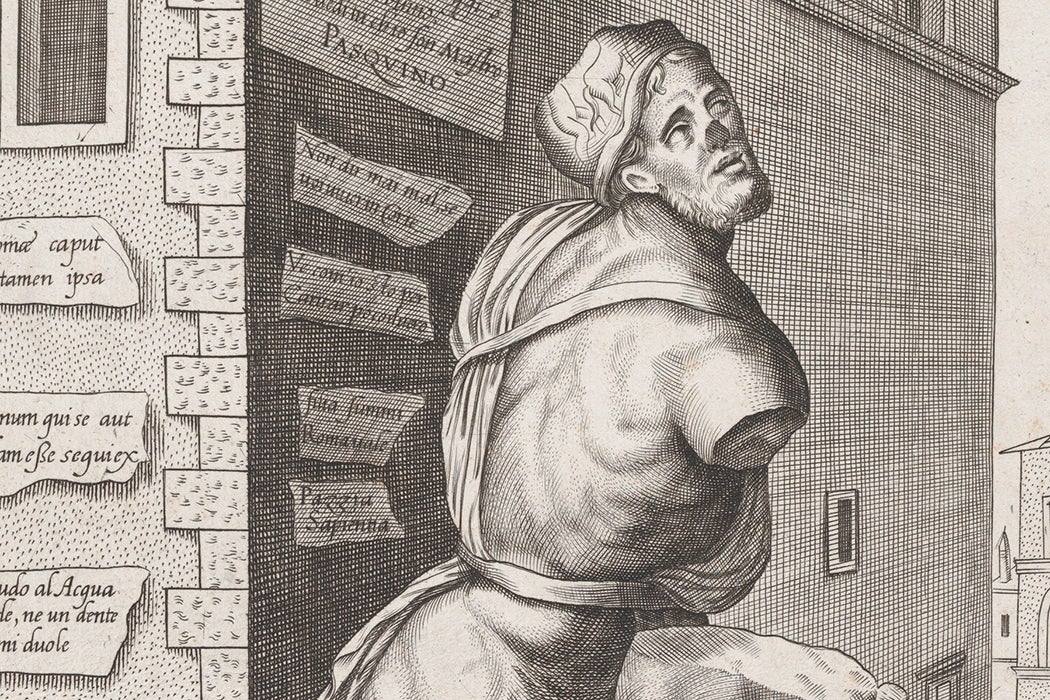In sixteenth-century Rome, an excavated third-century BCE Hellenistic statue began to “speak.” The statue, nicknamed Pasquino, openly mocked the oppressive papal government from his prominent intersection near the busy Piazza Navona. He was later joined by the half-man/half-goat Babuino, the barrel-carrying Il Facchino, the colossal Roman lady Madama Lucrezia, the toga-wearing Abbot Luigi, and the lounging river god Marforio. Known as the Congregation of Wits, the statues acted as places for public dialogue, when anonymous authors pasted short Latin verses satirizing the pope and other authority figures onto or beside their forms.
These verses animated them with a power of speech that was forbidden to ordinary Romans. “Pasquino was first and foremost considered a living voice of and for the popolo [people], speaking to a Roman public that in turn spoke back,” writes rhetoric scholar Christopher J. Gilbert in his exploration of the pasquinade tradition for Rhetoric and Public Affairs.
Leaving such irreverent messages in the sixteenth century could have serious consequences. Historian Laurie Nussdorfer writes in The Sixteenth Century Journal that in 1636, “an aristocrat had lost his head in Rome merely for possessing a manuscript of ‘pasquinades’ that made fun of Urban VIII’s government.” Pope Adrian VI in the 1520s wanted to toss Pasquino in the Tiber River; Benedict XIII in the 1720s issued an edict that promised a death sentence for anyone who left verses at the statues. Yet under cover of darkness, the messages continued. As one early nineteenth-century repartee went between two of the statues: “‘Pasquino, why has oil got so expensive?,’ Marforio asked. ‘Because Napoleon needs it to fry republics and anoint kings,’ Pasquino responded.”
The statues have kept talking. Indeed, in 2011, declarations like “Italy is not a brothel” and “The body of Italy is not for sale” manifested at Pasquino in response to the sex scandals around then Prime Minister Silvio Berlusconi. Recent clean-up efforts removed the graffiti behind Babuino and relegated the messages at Pasquino to an adjacent board. But, as Gilbert writes, during the restoration when the statue of Pasquino was wrapped up, “there appeared one day the following pasquinade: ‘Potete pure fasciarlo ma Pasquino non stara mai zitto’ (You can wrap Pasquino well but he will never shut up).”
Want more stories like this one?
Although the importance of the talking statues has faded with the rise of other media and a greater freedom of speech, the forum has an enduring influence in Rome’s political expression. As art historian Howard Risatti explains in Art Journal, with “the development of inexpensive imaging techniques and paper in the late eighteenth and early nineteenth centuries, the pasquinade was transformed into the pictorial political poster.” Even beyond Italy, a satirical public lampoon is called a “pasquinade.” While today the talking statues may be less plastered with layers of scrawled paper, these stone figures still represent the collective voice of the people, and a reminder that it cannot be silenced.







